When Linus Pauling died on Aug. 19, 1994, the world lost one of its greatest scientists and humanitarians and a much respected and beloved defender of civil liberties and health issues…
Because of his dynamic personality and his many accomplishments in widely diverse fields, it is hard to define Linus Pauling adequately. A remarkable man who insistently addressed certain crucial human problems while pursuing an amazing array of scientific interests, Dr. Pauling was almost as well known to the American public as he was to the world’s scientific community. He is the only person ever to receive two unshared Nobel Prizes — for Chemistry (1954) and Peace (1962).
In addition to the general recognition as one of the two greatest scientists of the 20th century, he was usually acknowledged by his colleagues as the most influential chemist since Lavoisier, the 18th-century founder of the modern science of chemistry. His introductory textbook General Chemistry, revised three times since its first printing in 1947 and translated into 13 languages, has been used by generations of undergraduates. After Pauling entered the field of chemistry as a professional in the mid-1920s, his work, grounded in physics, has affected the work of every chemist. He is also often considered the founding father of molecular biology, which has transformed the biological sciences and medicine and provided the base for biotechnology.
A multifaceted genius with a zest for communication, Linus Pauling for years was probably the most visible, vocal, and accessible American scientist. A black beret worn over a shock of curly white hair became his trademark, along with a pair of lively blue eyes that conveyed his intense interest in challenging topics. He was a master at explaining difficult medical and scientific information in terms understandable to intelligent laypersons. He wrote numerous articles and books for the general public — on science, peace, and health. Popular books in which Linus Pauling detailed his nutritional recommendations are Vitamin C and the Common Cold, Cancer and Vitamin C (with Ewan Cameron, M.D.), and How to Live Longer and Feel Better. He was perennially sought as a speaker for conferences, political rallies, commencements, and media programs.
At the same time, Linus Pauling produced a multitude of scholarly scientific papers on an astounding variety of subjects in numerous research fields. Of the over 1,000 articles and books he published as sole or joint author, about two-thirds are on scientific subjects. His landmark book The Nature of the Chemical Bond is frequently cited as the most influential scientific book of the 20th century.
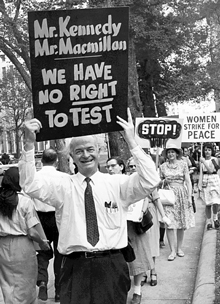
Linus Pauling was never reluctant to inspire or enter into controversy by expressing unorthodox scientific ideas, taking a strong moral position, or rousing the public to some worthy cause. He often provoked the scientific, medical, and political communities with his imaginative scientific hypotheses and strong social activism. He took professional and personal risks that most of his colleagues avoided. Steadfast and stubborn, yet rarely losing his cheerful equilibrium, he continued on his chosen and sometimes solitary path as a visionary of science and a prophet of humanity.
To give one example of his committed yet free-spirited nature: In 1962, during the Kennedy administration, the Paulings were invited to a special party at the White House honoring Nobel laureates. Dr. Pauling spent the day outside the gates carrying a placard that protested atmospheric nuclear testing. Then that evening, he and his wife sat down to an elegant dinner with the Kennedys. And, when energetic music was played, the couple felt inspired to get up and dance — to the delight of onlookers.
Important discoveries
Over the seven decades of his scientific career, Pauling’s research interests were amazingly wide-ranging and eclectic. He made important discoveries in many different fields of chemistry — physical, structural, analytical, inorganic, and organic chemistry, as well as biochemistry. He used theoretical physics, notably quantum theory and quantum mechanics, in his investigations of atomic and molecular structure and chemical bonding. He ventured into metallurgy and mineralogy through the study of atomic structures and bonding of metals and minerals and, with his colleagues, published the structures of hundreds of inorganic substances, including topaz and mica. In both theoretical and applied medicine, he made important discoveries in genetic diseases, hematology, immunology, brain function and psychiatry, molecular evolution, nutritional therapy, diagnostic technology, statistical epidemiology, and biomedicine.
Much of Pauling’s lifework combined the dedication and knowledge of the scientist with a deep commitment to humanitarianism that espoused his own operating ethical principle of the “minimization of suffering.”
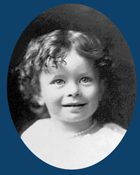
The early years
Linus Carl Pauling was born in Portland, Oregon, on February 28, 1901. He received his early education in Oregon, finishing in 1922 with a bachelor’s degree in chemical engineering from Oregon Agricultural College in Corvallis — now Oregon State University. Already he was drawn to the challenge of how and why particular atoms form bonds with each other to create molecules with unique structures.
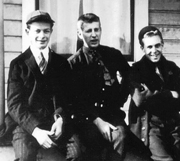
For postgraduate study, Pauling went to the California Institute of Technology (Caltech), which provided a stipend for research and teaching. In 1925 he received a Ph.D. in chemistry and mathematical physics. Awarded a Guggenheim Fellowship, in 1926-27 he studied in Europe with physicists who were exploring the implications of quantum mechanics for atomic structure. In this revolutionary new field, Pauling found a physical and mathematical framework for his own future theories regarding molecular structure and its correlation with chemical properties and function.

“Pauling’s Rules”
After Linus Pauling joined the Caltech faculty in the autumn of 1927, he continued his intensive research on the formation of chemical bonds between atoms in molecules and crystals. To chart bond angles and distances characteristic of particular atoms in relation to other atoms, he used x-ray diffraction (learned earlier as a graduate student) — supplemented after 1930 by electron diffraction, an even newer technique that he brought to the U.S. from Europe. Quantum mechanics enabled Pauling to explain the bonding phenomenon theoretically in a far more satisfactory way than before. He began to formulate generalizations regarding the atomic arrangements in crystals with ionic bonding, in which negatively charged electrons, orbiting around the positively charged nucleus, are transferred from one atom to another. “Pauling’s Rules” proved of great value in deciphering and interpreting ionic structures, particularly the complex ones of many silicate minerals.
Electronegativity, hybridization, and resonance
Pauling discovered that in many cases the type of bonding — whether ionic or covalent (formed by a sharing of electrons between bonded atoms) — could be determined from a substance’s magnetic properties. He also established an electronegativity scale of the elements for use in bonds of an intermediate character (having both ionic and covalent bonding); the smaller the difference in electronegativity between two atoms, the more the bond between them approaches a purely covalent bond. To explain covalent bonding, Pauling introduced two major new concepts, based on quantum mechanics: bond-orbital hybridization and bond resonance.
Hybridization reorganizes an atom’s electron cloud so that some electrons assume positions favorable for bonding. Since the carbon atom can form four bonds, tetrahedrally arranged — a central structural feature of organic chemistry — Pauling’s explanation of it and of many related features of covalent bonding attracted attention from chemists around the world. Resonance is a rapid jumping of electrons back and forth between two or more possible positions in a bond network. Resonance makes a major contribution to the structural geometry and stability of many substances, such as benzene or graphite, for which a static, non-resonating bond system would be inadequate. Pauling later extended his bond resonance concept to a theory of bonding in metals and intermetallic compounds.
Pauling’s innovative concepts, published beginning in the late 1920s, together with numerous examples of their application to particular chemical compounds or compound groups gave chemists fundamental principles to apply to the growing body of chemical knowledge. They could also accurately predict new compounds and chemical reactions on a theoretical basis that was far more satisfactory than the straight empiricism of pre-Pauling chemistry.
The definitive book
In 1939 Pauling brought together his work on these subjects in his definitive book The Nature of the Chemical Bond and the Structure of Molecules and Crystals, which became a classic and was translated into many languages. Its third edition appeared in 1960 and has remained in print to this day. The original handwritten manuscript was given by a former student of Pauling’s to the Linus Pauling Institute of Science and Medicine and is now part of the Ava Helen and Linus Pauling Papers in the Valley Library at Oregon State University.
Pauling’s interest in molecular structure continued throughout his long career, and the theoretical calculations involved meant utter happiness to him. He used what he called the “stochastic method,” which drew upon his own encyclopedic knowledge and formidable memory and allowed him to postulate a likely molecular structure, based on reasoning and theoretical calculation. Detailed laboratory verifications would often be carried out by associates — as with most of his research projects. Many of his discoveries and inventions were then expanded upon and utilized profitably in the industry by others. And though in later years he was primarily involved in biomedical research, his curiosity often impelled him to identify the intricate structures of many clay minerals, transition metals, intermetallic compounds, and other substances. In 1992 he was awarded one of his last patents for a novel technique of fabricating superconductive materials.

Teaching freshman chemistry
In the early 1930s, Pauling took over the teaching of freshman chemistry at Caltech. His modern theoretical approach to chemistry, charismatic lecturing style, and energetic showmanship (the laboratory demonstrations occasionally become pyrotechnical displays) made him a very popular professor. He also told students about his current research, giving them insight into the professional chemist’s work. In 1947 he put his new approach to chemical education into General Chemistry, a textbook that greatly influenced the teaching of chemistry worldwide by redirecting it from its traditional, purely empirical basis into the new “chemical bond approach.”
Physiology and health
Pauling’s involvement with human physiology and health, which dominated the last three decades of his research career, had long precedents. During the mid-1930s a significant part of his research, generously funded by the Rockefeller Foundation, moved into biochemistry — a field he had previously avoided — as he became increasingly interested in the highly complex molecules within living organisms. Applying techniques used in earlier diffraction studies to biological compounds, he now sought to understand the structure of proteins.
In 1934 he investigated the magnetic properties of hemoglobin, the oxygen-carrying molecule in red blood cells. He then studied the roles of antigens and antibodies in the immune response, one aspect of the important phenomenon of specificity in biochemical interactions.
In 1940 he made the novel proposal that this specificity is achieved through molecular complementariness, which he regarded as the secret of life. The concept — involving a “hand-in-glove” fit of one molecule against or into another molecule that has a shape complementary to the first — was tested in his laboratory over the next 10 years by means of numerous serological experiments, yielding results published in no less than 34 scientific papers. In 1946 Pauling postulated that the gene might consist of two mutually complementary strands — a concept anticipating Watson and Crick’s discovery of DNA structure seven years later.
Molecular disease
Pauling originated the concept of molecular disease. In 1945, while hearing a physician describe sickle cell anemia, he instantly surmised that it might be caused by a defect in the red blood cell’s hemoglobin. After three years of painstaking research, he and his associate Dr. Harvey Itano identified this prevalent disease as molecular in origin — caused by a genetically transmitted abnormality in the hemoglobin molecule. In susceptible patients, hemoglobin molecules in venous blood, lacking oxygen, become self-complementary; distorted, they stick together and form long rods that interfere with blood circulation.
Pauling’s description of this first molecular disease (as he called it) initiated a search for many more such disorders. The new idea quickly became immensely important in medicine and is now the main focus of human genome research. Thus the medical specialties of hematology, serology, immunology, applied genetics, and pathology owe much to Pauling’s contributions, which were made long before his intense interest in the promise of nutritional therapy became widely known.
World War II
When World War II began, Dr. Pauling offered the U.S. government the use of his laboratory and of his services as a research consultant. He devised some impressive explosives (one called “Linusite”!) and missile propellants for the Navy. He invented a meter that monitored oxygen levels in submarines and airplanes; the device later provided invaluable in ensuring safe levels of that life-sustaining gas for premature infants in incubators and for surgery patients under anesthesia.
With an associate, Dr. Pauling originated a synthetic form of blood plasma for use in emergency transfusions in battlefield clinics. He also took part in a wartime presidential commission formed to recommend future directions of government-funded scientific and medical research programs. Two major outcomes were the postwar expansion of the National Institutes of Health (NIH), allowing for extramural research funding, and the creation of the National Science Foundation. Acknowledging Pauling’s patriotic wartime activities, President Harry Truman in 1948 presented the Presidential Medal for Merit to him “for outstanding services to the United States from October 1940 to June 1946.”
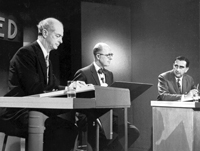
Speaking out
With the war ended, Pauling again focused on his protein-structure studies at Caltech. But he had new distractions, brought on by the dawning Atomic Age. Along with other eminent scientists (such as Einstein) who felt a moral imperative to voice concerns about where the post-Hiroshima human society was heading, he began to speak out against further development, testing, abuse of nuclear arms, as well as against new state-imposed “loyalty oaths.”
During the infamous McCarthy era in the early 1950s, he was treated almost as a traitor. Despite his past patriotism, for several years he was denied a passport to travel abroad to scientific conferences. The State Department’s reason: “Not in the best interests of the United States.” Only in 1954, when Pauling received the Nobel Prize in Chemistry, was an unrestricted passport reinstated.
The alpha helix
 While a visiting lecturer at Oxford University in 1948, Pauling had a sudden insight regarding the fundamental structure of proteins, an insight that had eluded him for more than a decade. Working with a sheet of paper that he folded over at sites where he knew from theoretical considerations that the chain could bend, he found that the polypeptide chain, formed from sequences of amino acids, would coil into a particular helical structure, which he named the alpha helix. He based this theoretical configuration on chemical-bonding considerations plus x-ray diffraction evidence from certain fibrous proteins. This proposal, as well as a companion concept of a related “pleated sheet” structure, proved correct. Subsequent x-ray diffraction studies have found that the alpha helix is a major component of both globular and fibrous proteins and extensively controls their structure and function.
While a visiting lecturer at Oxford University in 1948, Pauling had a sudden insight regarding the fundamental structure of proteins, an insight that had eluded him for more than a decade. Working with a sheet of paper that he folded over at sites where he knew from theoretical considerations that the chain could bend, he found that the polypeptide chain, formed from sequences of amino acids, would coil into a particular helical structure, which he named the alpha helix. He based this theoretical configuration on chemical-bonding considerations plus x-ray diffraction evidence from certain fibrous proteins. This proposal, as well as a companion concept of a related “pleated sheet” structure, proved correct. Subsequent x-ray diffraction studies have found that the alpha helix is a major component of both globular and fibrous proteins and extensively controls their structure and function.
A few years later, in 1953, Watson and Crick proposed that the structure for DNA, the genetic substance of living things, is a two-stranded double helix, with one strand of the helix complementary to the other. Pauling’s proposals of helical structure and molecular complementariness underlay their theory. (Possibly Pauling, who also pursued DNA’s structure, would have discovered the double helix himself had he attended a 1952 London conference and seen, as did Watson and Crick, crucial new DNA x-ray diffraction data, but this trip was prevented by the denial of a passport.) Confirmation and knowledge of the DNA structure immediately launched the new field of molecular genetics, which has revolutionized virtually all of biology.
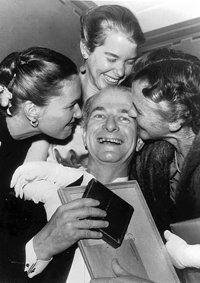
Nobel Prize in Chemistry
In 1954 Linus Pauling was awarded the Nobel Prize in Chemistry. The Royal Swedish Academy of Sciences cited his seminal work on the nature of the chemical bond and the structure of molecules and crystals and also acknowledged his application of the resulting concepts to elucidating the structure of proteins, specifically the alpha helix.
Nobel Peace Prize
Pauling put his elevated new position as a Nobel laureate to good effect in his growing social activism. In the late 1950s and early 1960s, he evolved into a fully heroic figure to hundreds of thousands of Americans who admired the chemist’s courageous protest against atmospheric nuclear testing. He maintained, using scientific data and statistics to make his points, that radioactive fallout would increase the incidence of cancer and genetic disorders, including birth defects. As international tension and competition between the U.S. and the Soviet Union accelerated, he also riveted public attention on the buildup and proliferation of nuclear weaponry — preparations for thermonuclear warfare that he believed would destroy most of the planet’s living creatures. He addressed both issues in his popular book No More War! (1958). He maintained that patient, reasoned negotiation and diplomacy, using the objectivity and procedures of the scientific method, would settle disputes in a more lasting, rational, and far more humane way than war. He asked scientists to become peacemakers.
 In this most intense phase of the Cold War, Linus Pauling’s name was often in the news — as when he circulated a petition against atmospheric nuclear testing and the excessive buildup of nuclear arsenals. The petition was presented in early 1958 to the United Nations after being signed by some 9,000 — eventually, more than 11,000-scientists worldwide. The U.S. government’s opposing position was defended — sometimes vituperatively — by most of the press and by various scientists, such as physicist Edward Teller, many of whom were federal employees.
In this most intense phase of the Cold War, Linus Pauling’s name was often in the news — as when he circulated a petition against atmospheric nuclear testing and the excessive buildup of nuclear arsenals. The petition was presented in early 1958 to the United Nations after being signed by some 9,000 — eventually, more than 11,000-scientists worldwide. The U.S. government’s opposing position was defended — sometimes vituperatively — by most of the press and by various scientists, such as physicist Edward Teller, many of whom were federal employees.
Pauling’s six-year unrelenting antitesting campaign was finally vindicated when a treaty was signed by the then-three nuclear powers — the U.S., Great Britain, and the U.S.S.R.
On October 10, 1963, the day on which the limited test ban went into effect, it was announced that Linus Pauling would be awarded the Nobel Peace Prize for 1962. A key member of the selection committee in Norway commented later that the treaty would probably not have been effected without Dr. Pauling’s galvanizing impetus. Its timely inception has spared innumerable people from suffering from cancer and genetic damage. Linus Pauling was greatly admired and is still much appreciated for his courageous public stand by many people who lived through those years. Today, of course, preventing nuclear warfare and fallout from above-ground weapons testing, as well as curbing the proliferation of nuclear arms, is the position accepted by most people worldwide.
Peace activist
Pauling believed that the creation of nuclear weapons meant that war must be abolished and the reign of world law instituted. Seeking the means to achieve durable, equitable peace in the nuclear age through rational dialogue, he originated and participated with other renowned scientists in a series of international Pugwash Conferences, which included Soviet representatives. For almost a decade, in the role of an elder statesman for peace, he protested adamantly against U.S. military action in Vietnam and elsewhere in Southeast Asia. He also criticized the U.S. for interfering in Latin American nations, as in Cuba and Nicaragua, and or waging war with Iraq in the Persian Gulf instead of using economic sanctions and negotiation. Decrying the strife within the former Yugoslavia, in 1991 he wrote “An Appeal for Peace in Croatia” and signed other international petitions that cited gross human-rights violations.
 Pauling often urged scientists to get involved in politics and society: “It is sometimes said that science has nothing to do with morality. This is wrong. Science is the search for truth, the effort to understand the world; it involves the rejection of bias, of dogma, of revelation, but not the rejection of morality… One way in which scientists work is by observing the world, making note of phenomena, and analyzing them.”
Pauling often urged scientists to get involved in politics and society: “It is sometimes said that science has nothing to do with morality. This is wrong. Science is the search for truth, the effort to understand the world; it involves the rejection of bias, of dogma, of revelation, but not the rejection of morality… One way in which scientists work is by observing the world, making note of phenomena, and analyzing them.”
In 1964 Linus Pauling left his tenured professorship at Caltech because of pressure from administrators and conservative trustees who disapproved of his prominent, persistent anti-nuclear and international peace-promoting activities. Pauling had been at the Institute for 42 years — first as a graduate student, then as a faculty member. (In 1937 he was appointed Chairman of its Division of Chemistry and Chemical Engineering and Director of the Gates and Crellin Laboratories — positions that he had abdicated in 1958 under administrative pressure.)
Pursuing humanitarian issues
Leaving Pasadena for Santa Barbara, Pauling became a founding fellow of the Center for the Study of Democratic Institutions, which enabled him to pursue humanitarian issues, particularly the use of scientific thinking in solving problems in modern society. Later he held professorships in chemistry at the University of California, San Diego (1967-69), and at Stanford University (1969-73).
In the mid-1950s Pauling extended his earlier interest in human physiology into studying the mental and somatic health of groups and individuals. Health statistics, which he had begun to use with his nuclear-hazard studies and antinuclear proselytizing, now became an epidemiological tool. For instance, he demonstrated statistically that smoking was a major threat to health, decreasing the average life span by eight years, well before the medical establishment began issuing strong warnings. He also studied other factors involved in longevity.
Orthomolecular medicine
Pauling had spoken about the importance of vitamins in the late 1930s. In the mid-1960s he became intrigued with the biochemistry of nutrition. Its roots were in the research he had done at Caltech on the mechanism of action of anesthetic agents in the brain and in exploring the possibility that mental retardation and mental illness (especially schizophrenia) were caused by various biochemical and genetic disorders. This work in brain-fluid chemistry — studying the molecular environment of the mind — later led to collaborative clinical research with Dr. Abram Hoffer on the therapeutic efficacy of vitamins in cancer. In founding the new field of orthomolecular psychiatry (“Orthomolecular Psychiatry” Science 160:265-271, 1968), Pauling proposed that mental abnormalities might be successfully treated by correcting imbalances or deficiencies among naturally occurring biochemical constituents of the brain, notably vitamins and other micronutrients, as an alternative to the administration of potent synthetic psychoactive drugs.
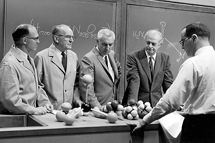 Pauling later broadened this concept into orthomolecular medicine. The concept and term (meaning “right molecules in the right concentration”) characterized an approach to the prevention and treatment of disease and attainment of optimum health that was based on the physiological and enzymatic actions of specific nutrients, such as vitamins, minerals, and amino acids present in the body.
Pauling later broadened this concept into orthomolecular medicine. The concept and term (meaning “right molecules in the right concentration”) characterized an approach to the prevention and treatment of disease and attainment of optimum health that was based on the physiological and enzymatic actions of specific nutrients, such as vitamins, minerals, and amino acids present in the body.
Vitamin C
Fascinated with the multifaceted role of vitamin C (ascorbic acid) in maintaining health, he began combing the scientific and medical literature for experimental and clinical evidence as to its importance. From published studies, from physiological and evolutionary reasoning, and from his and his wife’s own experiences, he became convinced of the value of vitamin C in large doses as a prophylactic or palliative for the common cold. In 1970 he wrote the book Vitamin C and the Common Cold, which became a bestseller and brought wide public attention while creating a huge and continuously increasing demand for this micronutrient.
Later he became convinced of ascorbate’s value in combating the flu, cancer, cardiovascular disease, infections, and degenerative problems in the aging process. He added other micronutrients, such as vitamin E and the B vitamins, to his list of helpful supplements and published two other popular books and a number of papers, both scientific and popular, on nutritional therapy. As happened during his earlier efforts in awakening the public to the dangers of nuclear weapons, Pauling’s pronouncements on the subject of nutritional medicine were often assailed by physicians and physicians’ organizations that ignored his long and insightful involvement with the biochemistry of human health and much of the published studies. They often dismissed his ideas as quackery.
The LPI
After retiring to the status of Professor Emeritus at Stanford in 1973, Pauling co-founded the nonprofit biomedical research organization that now bears his name. The Linus Pauling Institute of Science and Medicine was established primarily to conduct research and education in orthomolecular medicine, following his belief that nutrition could prevent, ameliorate or cure many diseases, slow the aging process, and alleviate suffering.
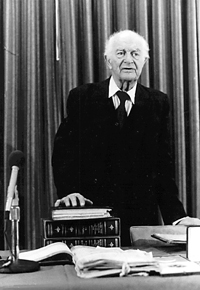 At LPI Pauling and his staff worked on developing diagnostic tests and tools for analyzing a multitude of compounds found in bodily fluids. In his view, biochemical individuality — involving unique dietary needs specific to individuals — determines how optimum health can be achieved through the judicious use of natural substances. He maintained that biochemical individuality, molecular disease, or environmental stress may increase the need for certain micronutrients, such as vitamin C, considerably above the RDA. He also warned against the overuse of such substances as sugar and chemical sweeteners. Unlike many advocates in the field of nutritional medicine, he considered orthomolecular medicine a crucial adjunct to standard medical practice and therefore did not rule out conventional treatments, such as surgery, chemotherapy, and radiation, when considered appropriate.
At LPI Pauling and his staff worked on developing diagnostic tests and tools for analyzing a multitude of compounds found in bodily fluids. In his view, biochemical individuality — involving unique dietary needs specific to individuals — determines how optimum health can be achieved through the judicious use of natural substances. He maintained that biochemical individuality, molecular disease, or environmental stress may increase the need for certain micronutrients, such as vitamin C, considerably above the RDA. He also warned against the overuse of such substances as sugar and chemical sweeteners. Unlike many advocates in the field of nutritional medicine, he considered orthomolecular medicine a crucial adjunct to standard medical practice and therefore did not rule out conventional treatments, such as surgery, chemotherapy, and radiation, when considered appropriate.
As a prominent, knowledgeable, and articulate spokesman for the use of nutrients as means to achieve health, prolong life and provide inexpensive, readily available, non-toxic alternatives to drugs, Pauling gained a large number of ardent admirers among the public. There were also doubters and detractors. To the attacks from physicians and other authorities in medicine who through the years dismissed or ridiculed his assertions, Pauling responded with cogent research data and logical reasoning. As happened earlier with his outspoken antinuclear and peace activism, and even to some extent with his original work on the nature of the chemical bond, assaults from critics did not stop Pauling from maintaining his position, and he was often regarded as a besieged hero. He utilized the media’s ongoing interest in him to good effect in promoting his “regimen for better health,” with vitamin C as its keystone. Doubtless, the public today knows Dr. Linus Pauling more for his advocacy of vitamin C and orthomolecular medicine than for his work on the chemical bond or for world peace.
The final years
 In the last few years of his life, Pauling cut down on his previously frequent worldwide lecturing and associated travel. He largely divided his time between his coastal ranch, where he did theoretical work and wrote for publication, and his apartment at Stanford close to the Linus Pauling Institute, where he served as Director of Research after resigning from the chairmanship of the Board of Trustees in 1992.
In the last few years of his life, Pauling cut down on his previously frequent worldwide lecturing and associated travel. He largely divided his time between his coastal ranch, where he did theoretical work and wrote for publication, and his apartment at Stanford close to the Linus Pauling Institute, where he served as Director of Research after resigning from the chairmanship of the Board of Trustees in 1992.
Pauling continued to publish articles about health as well as reminiscences of his career in science and his peace work. He wrote many scientific papers on orthomolecular medicine and on structural chemistry. The latter included detailing his unorthodox close-packed “polyspheron” theory of the structure of atomic nuclei and nuclear fission from a structural chemist’s point of view, and an explanation (based on the twinning phenomenon in crystals) of the baffling “quasicrystal” diffraction patterns from certain alloys, which seem to show a five-fold symmetry contrary to the laws of classical crystallography. He pursued these subjects nearly to the time of this death.
In retrospect, the breadth of Pauling’s interests and research was enormous and his published work prodigious — more than 1,065 publications, from scientific and popular books and articles to book forewords and reviews to letters to editors and printed speeches.
Numerous honors
To Linus Pauling came many honors. In 1933, at the remarkably young age of 32, he was elected to the prestigious National Academy of Sciences, and in 1936 to the equally prestigious American Philosophical Society. In 1948 he became a foreign member of The Royal Society of London, the premier honorary scientific society of Great Britain. Many other scientific societies and associations throughout the world made him a member or honorary member. In chemistry, in addition to the Nobel Prize (1954), Pauling was given numerous awards, including the Davy, Pasteur, Willard Gibbs, T.W. Richards, G.N. Lewis, Priestley, Avogadro, and Lomonosov medals. He was the first recipient of the National Academy of Sciences Award in Chemical Sciences, in 1979. The National Library of Medicine gave him its Sesquicentennial Commemorative Award in 1986; he was given other notable medical awards, such as the Addis, Phillips, Virchow, Lattimer, and the French Academy of Medicine medals. He received the Martin Luther King, Jr. Medical Achievement Award for his pioneering work in determining the cause of sickle cell anemia — the molecular disease prevalent among African-Americans.
 President Ford awarded him the National Medal of Science in 1975, and in 1989 the National Science Board presented him with the Vannevar Bush Award in recognition of his outstanding contributions to science, technology, and society. He also received prominent medals and awards in mineralogy, international law, philosophy, and the social sciences. Among the humanitarian awards Pauling won, the most notable, of course, was the Nobel Peace Prize for 1962; he was also given the Gandhi and Lenin peace prizes and the Albert Schweitzer Peace medal. Pauling was named Humanist of the Year in 1961. Pauling also received the Gold Medal of the National Institute of Social Sciences. In addition, Pauling was awarded honorary degrees by some 50 universities and colleges throughout the world. Several universities have created their own Linus Pauling Lectureship or Medal, to honor other scientists or humanitarians in his name.
President Ford awarded him the National Medal of Science in 1975, and in 1989 the National Science Board presented him with the Vannevar Bush Award in recognition of his outstanding contributions to science, technology, and society. He also received prominent medals and awards in mineralogy, international law, philosophy, and the social sciences. Among the humanitarian awards Pauling won, the most notable, of course, was the Nobel Peace Prize for 1962; he was also given the Gandhi and Lenin peace prizes and the Albert Schweitzer Peace medal. Pauling was named Humanist of the Year in 1961. Pauling also received the Gold Medal of the National Institute of Social Sciences. In addition, Pauling was awarded honorary degrees by some 50 universities and colleges throughout the world. Several universities have created their own Linus Pauling Lectureship or Medal, to honor other scientists or humanitarians in his name.
Nine biographies and three anthologies of his writings and speeches have been published thus far, and a two-volume collection of many of his most important scientific publications was published in 2002.
Personal life
 Linus Pauling always emphasized the importance of having a full and happy personal life. In 1923 he married Ava Helen Miller, who had been a student in a chemistry course he taught while still an undergraduate at Oregon Agricultural College. Dr. Pauling frequently credited his wife with influencing the development of his social consciousness. She was greatly involved in peace activities, both with her husband and on her own. Pauling said that his Nobel Peace Prize should really have gone to her, or at least been shared between them. In his talks and informal writings he often spoke both tenderly and humorously of their complementary partnership. She died in 1981. In tribute to her dedication to world peace, the Ava Helen and Linus Pauling Lectureship in World Peace has been established by the Paulings’ alma mater, Oregon State University in Corvallis, where the Paulings’ papers, medals, and other memorabilia are housed in Special Collections at the Valley Library. Additionally, the Linus Pauling Institute established the endowed Ava Helen Pauling Chair in 2001 to honor Ava Helen Pauling’s memory.
Linus Pauling always emphasized the importance of having a full and happy personal life. In 1923 he married Ava Helen Miller, who had been a student in a chemistry course he taught while still an undergraduate at Oregon Agricultural College. Dr. Pauling frequently credited his wife with influencing the development of his social consciousness. She was greatly involved in peace activities, both with her husband and on her own. Pauling said that his Nobel Peace Prize should really have gone to her, or at least been shared between them. In his talks and informal writings he often spoke both tenderly and humorously of their complementary partnership. She died in 1981. In tribute to her dedication to world peace, the Ava Helen and Linus Pauling Lectureship in World Peace has been established by the Paulings’ alma mater, Oregon State University in Corvallis, where the Paulings’ papers, medals, and other memorabilia are housed in Special Collections at the Valley Library. Additionally, the Linus Pauling Institute established the endowed Ava Helen Pauling Chair in 2001 to honor Ava Helen Pauling’s memory.
 The Paulings had four children. Linus Pauling, Jr., M.D., a psychiatrist, lives in Honolulu. Peter Pauling, Ph.D., a crystallographer and retired lecturer in chemistry, resided in Wales until his death in 2003. Linda Pauling Kamb lives in the home originally built by her parents in the foothills above Pasadena. Her husband, a former Caltech professor of geology and vice president and provost, died in 2011. Crellin Pauling, Ph.D., was a professor of biology at San Francisco State University until his death in 1997. There are 15 grandchildren and 19 great-grandchildren.
The Paulings had four children. Linus Pauling, Jr., M.D., a psychiatrist, lives in Honolulu. Peter Pauling, Ph.D., a crystallographer and retired lecturer in chemistry, resided in Wales until his death in 2003. Linda Pauling Kamb lives in the home originally built by her parents in the foothills above Pasadena. Her husband, a former Caltech professor of geology and vice president and provost, died in 2011. Crellin Pauling, Ph.D., was a professor of biology at San Francisco State University until his death in 1997. There are 15 grandchildren and 19 great-grandchildren.
Following Pauling’s death at the age of 93 at his ranch near Big Sur on the California coast, a memorial service was held at Stanford Memorial Church in Palo Alto on Aug. 29
LPI moves to OSU
The assets of the Linus Pauling Institute of Science and Medicine were used to establish the Linus Pauling Institute as a research institute at OSU in 1996 to investigate the function and role of micronutrients, phytochemicals, and other constituents of food in maintaining human health and preventing and treating disease; and to advance the knowledge in areas which were of interest to Linus Pauling through research and education. LPI continues to function as a working tribute to a great scientist, Linus Pauling.










































